沙博理个人简介
《水浒传》沙博理译本的研究

《水浒传》沙博理译本的研究《水浒传》是中国古典小说中的经典之作,为了更好地传播这部作品,各国学者纷纷进行翻译和研究。
在《水浒传》的英文翻译中,沙博理的译本备受瞩目。
本文将对沙博理译本进行研究,分析其特点和对《水浒传》的传播和理解所起到的作用。
我们将简要介绍沙博理的译本。
沙博理是美国著名的中国文学学者和翻译家,他的《水浒传》英文译本是在20世纪60年代出版的。
这个译本是基于现代汉语的翻译,注重用通俗易懂的英语表达《水浒传》的故事情节和人物形象。
沙博理的译本在西方引起了巨大的反响,成为了西方读者理解中国古典文学的重要窗口之一。
我们将分析沙博理译本的特点。
沙博理在翻译《水浒传》时,注重了对故事情节和人物形象的忠实再现。
他用通俗易懂的语言,生动地描述了梁山泊108将的英雄事迹,使得西方读者能够更加深入地了解这些人物的性格特点和命运。
沙博理还在译本中加入了大量的注释和解释,帮助西方读者更好地理解中国古代社会的历史背景和文化特点。
这些特点使得沙博理的译本在西方受到了广泛的认可和赞扬。
然后,我们将探讨沙博理译本对《水浒传》在西方的传播和理解所起到的作用。
沙博理的译本不仅仅是一部简单的翻译作品,更是对中国古典文学的重新诠释和表达。
通过沙博理的译本,西方读者能够更加深入地了解《水浒传》中所蕴含的中国传统文化和价值观念,从而增进对中国文化的理解和认同。
沙博理的译本也为西方学术界对中国古典文学的研究提供了重要的参考资料。
通过对《水浒传》的翻译和解读,西方学者们能够更好地探讨中国文学对世界文化的影响和贡献,促进中西文化交流和理解。
我们将展望沙博理译本的翻译与传播的未来。
随着中国在国际舞台上的影响力不断增强,中国古典文学在世界范围内的传播和研究也将变得更加重要。
沙博理的译本为西方读者提供了独特的理解《水浒传》的途径,但同时也存在着一定的局限性。
未来的翻译工作需要不断地更新和完善,以满足不同国家和地区读者的阅读需求和审美观念。
翻译文化成就终身奖

:“翻译文化终身成就奖”获得者沙博理、许渊冲、草婴、屠岸、李士俊简介“翻译文化终身成就奖”获得者沙博理简介沙博理先生1915年12月23日出生于美国纽约,1937年毕业于圣约翰大学法律系。
第二次世界大战期间加入美国陆军服役,成为一名高射炮士兵。
美国由于时局的需要,决定培养一批军人学习世界语言,沙博理被派去学中文和中国的历史文化。
退伍后沙博理利用退伍津贴进入哥伦比亚大学学习中文和中国历史文化,后转到耶鲁大学继续学习。
1947年4月他远渡重洋来到中国,在上海接触了进步的中外人士,由同情转而投身于中国革命。
他曾用做律师所得到的钱,支持中国同志创办进步刊物《人世间》。
1948年,他与著名演员和进步作家凤子结为夫妇,并于1949年10月1日,和凤子应邀参加了开国大典,沙博理从此定居中国,并以外国专家的身份满腔热忱投身于新中国的建设事业。
沙博理先在对外文化联络局做英文翻译,1951年英文版《中国文学》创刊后,他来到杂志社从事审译工作。
作为新中国文学向西方传播的前驱使者,他相继翻译了美国出版的第一部反映“红色中国”的小说《新儿女英雄传》、著名作家巴金的《家》、茅盾的《春蚕》以及《林海雪原》、《保卫延安》、《创业史》、《月芽》、《孙犁小说选》等著名小说。
1963年,经周恩来总理批准,沙博理加入了中国国籍,成为中国公民。
十年动乱期间,沙博理翻译完成的中国古典文学名著《水浒传》成为中国文学翻译史上举足轻重的作品,并为之赢得中国文联最高翻译奖。
笔耕之余,由于夫人凤子的关系,他还走上银幕,在《停战以后》、《长空雄鹰》、《西安事变》三部影片中客串过角色。
1971年以后,沙博理先生十余次访美探亲。
在美国期间,他应邀到许多地方做报告,向美国人民介绍中国。
为外刊撰文,介绍中国的情况。
1972年,沙博理先生到人民画报社任英文改稿专家。
多年来,沙博理先生除了倾全力翻译中国文学作品外,还陆续撰写了自传体著作《一个美国人在中国》和《我的中国》,以及研究中国问题的著述《四川的经济改革》、《中国封建社会的刑法》、《中国学者研究古代中国的犹太人》、《马海德传》等书,先后在中国、美国、以色列、新加坡等国出版,引起很大反响。
《水浒传》沙博理译本的研究
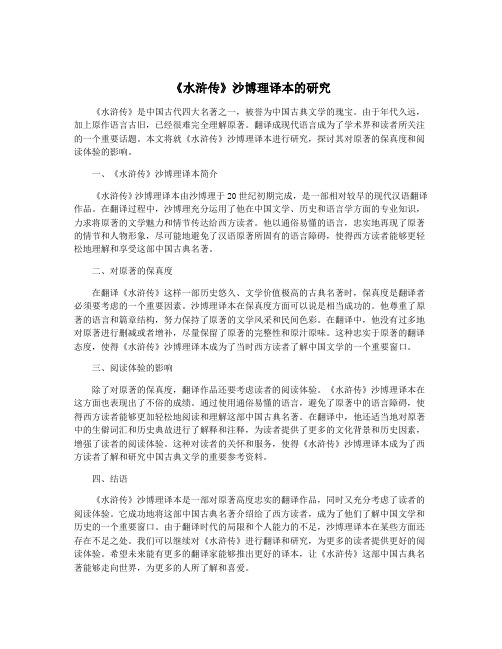
《水浒传》沙博理译本的研究《水浒传》是中国古代四大名著之一,被誉为中国古典文学的瑰宝。
由于年代久远,加上原作语言古旧,已经很难完全理解原著。
翻译成现代语言成为了学术界和读者所关注的一个重要话题。
本文将就《水浒传》沙博理译本进行研究,探讨其对原著的保真度和阅读体验的影响。
一、《水浒传》沙博理译本简介《水浒传》沙博理译本由沙博理于20世纪初期完成,是一部相对较早的现代汉语翻译作品。
在翻译过程中,沙博理充分运用了他在中国文学、历史和语言学方面的专业知识,力求将原著的文学魅力和情节传达给西方读者。
他以通俗易懂的语言,忠实地再现了原著的情节和人物形象,尽可能地避免了汉语原著所固有的语言障碍,使得西方读者能够更轻松地理解和享受这部中国古典名著。
二、对原著的保真度在翻译《水浒传》这样一部历史悠久、文学价值极高的古典名著时,保真度是翻译者必须要考虑的一个重要因素。
沙博理译本在保真度方面可以说是相当成功的。
他尊重了原著的语言和篇章结构,努力保持了原著的文学风采和民间色彩。
在翻译中,他没有过多地对原著进行删减或者增补,尽量保留了原著的完整性和原汁原味。
这种忠实于原著的翻译态度,使得《水浒传》沙博理译本成为了当时西方读者了解中国文学的一个重要窗口。
三、阅读体验的影响除了对原著的保真度,翻译作品还要考虑读者的阅读体验。
《水浒传》沙博理译本在这方面也表现出了不俗的成绩。
通过使用通俗易懂的语言,避免了原著中的语言障碍,使得西方读者能够更加轻松地阅读和理解这部中国古典名著。
在翻译中,他还适当地对原著中的生僻词汇和历史典故进行了解释和注释,为读者提供了更多的文化背景和历史因素,增强了读者的阅读体验。
这种对读者的关怀和服务,使得《水浒传》沙博理译本成为了西方读者了解和研究中国古典文学的重要参考资料。
四、结语《水浒传》沙博理译本是一部对原著高度忠实的翻译作品,同时又充分考虑了读者的阅读体验。
它成功地将这部中国古典名著介绍给了西方读者,成为了他们了解中国文学和历史的一个重要窗口。
沙博理的文化身份对其“农村三部曲”英译本的影响
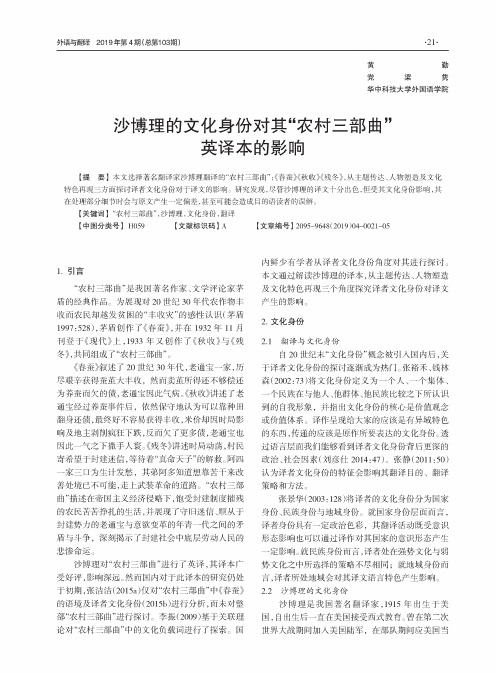
黄勤党梁隽华中科技大学外国语学院沙博理的文化身份对其“农村三部曲”英译本的影响【提要】本文选择著名翻译家沙博理翻译的“农村三部曲”:《春蚕》《秋收》《残冬》,从主题传达、人物塑造及文化特色再现三方面探讨译者文化身份对于译文的影响。
研究发现,尽管沙博理的译文十分出色,但受其文化身份影响,其在处理部分细节时会与原文产生一定偏差,甚至可能会造成目的语读者的误解。
【关键词】“农村三部曲”,沙博理,文化身份,翻译【中图分类号】H059【文献标识码】A【文章编号】2095-9648(2019)04-0021-051.引言“农村三部曲”是我国著名作家、文学评论家茅盾的经典作品。
为展现对20世纪30年代农作物丰收而农民却越发贫困的“丰收灾”的感性认识(茅盾1997:528),茅盾创作了《春蚕》,并在1932年11月刊登于《现代》上,1933年又创作了《秋收》与《残冬》,共同组成了“农村三部曲”。
《春蚕》叙述了20世纪30年代,老通宝一家,历尽艰辛获得蚕茧大丰收,然而卖茧所得还不够偿还为养蚕而欠的债,老通宝因此气病。
《秋收》讲述了老通宝经过养蚕事件后,依然保守地认为可以靠种田翻身还债,最终好不容易获得丰收,米价却因时局影响及地主剥削疯狂下跌,反而欠了更多债,老通宝也因此一气之下撒手人寰。
《残冬》讲述时局动荡,村民寄希望于封建迷信,等待着“真命天子”的解救。
阿四一家三口为生计发愁,其弟阿多知道想靠苦干来改善处境已不可能,走上武装革命的道路。
“农村三部曲”描述在帝国主义经济侵略下,饱受封建制度摧残的农民苦苦挣扎的生活,并展现了守旧迷信、顺从于封建势力的老通宝与意欲变革的年青一代之间的矛盾与斗争,深刻揭示了封建社会中底层劳动人民的悲惨命运。
沙博理对“农村三部曲”进行了英译,其译本广受好评,影响深远。
然而国内对于此译本的研究仍处于初期,张洁洁(2015a)仅对“农村三部曲”中《春蚕》的语境及译者文化身份(2015b)进行分析,而未对整部“农村三部曲”进行探讨。
周明伟:我与沙老的十年—中国外文局局长谈沙博理

“我不是什么大师,我希望自己是一座桥,能沟通中文和英文,沟通中国和世界,使世界上不论什么肤色、哪个族群或信仰何种宗教的人们,都能来看看中国风景,读读中国故事,听听中国声音。
”美裔中国籍翻译家沙博理这样比喻自己。
2004年底,中国外文局局长周明伟第一次拜访沙博理,沙老这段话让他印象深刻。
从那以后,每逢沙老生日或春节,周明伟都会去家里探望,送上生日蛋糕,准备几样沙老爱吃的菜肴。
沙博理愿意和周明伟聊天,聊武侠小说,聊中国文化和中国字,聊西方对中国的偏见与误解,偶尔也聊起沙博理挚爱一生的中国妻子凤子。
2014年10月18日星期六上午,周明伟正在参加一个会议,期间收到沙老去世周明伟:我与沙老的十年 ——中国外文局局长谈沙博理文| 温志宏沙博理热爱中国、热爱中华文化,始终关注世界大事和中国发展,对中国人民怀有真挚感情,对中国革命、建设和改革事业抱有极大热忱,对中国的前途和命运极为关心,对中国的对外传播事业极端负责。
2010年12月23日,中国外文局局长周明伟(右一)为人民画报社老专家沙博理举办95岁生日宴怀痛惜地向这位老人致以最后的敬意后,周明伟立即协调布置各项善后事宜,是第一个到场的“工作人员”。
今年春节去探望时,周明伟还和他一起议论着要办一个“沙博理作品展室”,谋划着沙老99岁的生日party。
周明伟感觉沙老消瘦很多,谈话间多次提到他的身体状况,询问是否有什么需要帮着做的,但沙博理不想去医院,他不愿借助任何辅助手段来维系生命。
他多次说,如果到了最后时刻,要在家里平平静静地走,不麻烦任何人。
周明伟始终觉得沙老是个“谜”。
1963年,经周恩来总理的批准,沙博理加入中国国籍,成为一名中国公民。
为什么一个在美国做过律师、当过兵的典型的美国人,却选择了60多年与中国同甘共苦,而且一辈子深深依恋着自己的中国妻子?沙博理曾对周明伟说,他当时非常自豪,一方面因为他是新中国成立后最早获得中国国籍的外裔人士之一,另一方面,他觉得从那时起,自己就不再是一个外来的、帮助中国的局外人,而变成一个在中国之内的、休戚与共的直接参与者。
外来翻译家沙博理研究综述——基于中国“红色”翻译时期(1949-1966)的分析

第 42卷 第 1期 2020年 3月
上 海 理 工 大 学 学 报 (社会科学版)
JournalofUniversityofShanghaiforScienceandTechnology
Vol.42 No.1 Mar.2020
外来翻译家沙博理研究综述
———基于中国“红色”翻译时期(1949—1966)的分析
聂 炜1, 张白桦2
(1.华中科技大学 外国语学院,湖北 武汉 430000; 2.内蒙古工业大学 外国语学院,内蒙古 呼和浩特 010080)
摘要:我国对于翻译家系统性研究的探讨始于 20世纪 80年代,通过近 30年的不断发展与完善, 探索出了逐渐清晰的研究脉络。虽然探索研究翻译家的研究范式日益规范,但研究所存在的问题 却日益凸显,具体表现在:研究对象的选择过于集中于名家名著,因而疏于对隐形价值翻译家的 挖掘与探索;研究途径浮于表层的史料钩沉,缺乏理论的支撑。试以翻译家西德尼·沙博理的 “红色” 翻译时期为历史语境,结合描述性翻译研究及文献计量法,梳理和归纳国内外对 “沙博 理” 的相关研究,描述学界对外来译家的研究现状,以期对后续以沙博理为代表的外来翻译家 研究有所裨益。
沙博理:我把中国讲给世界听
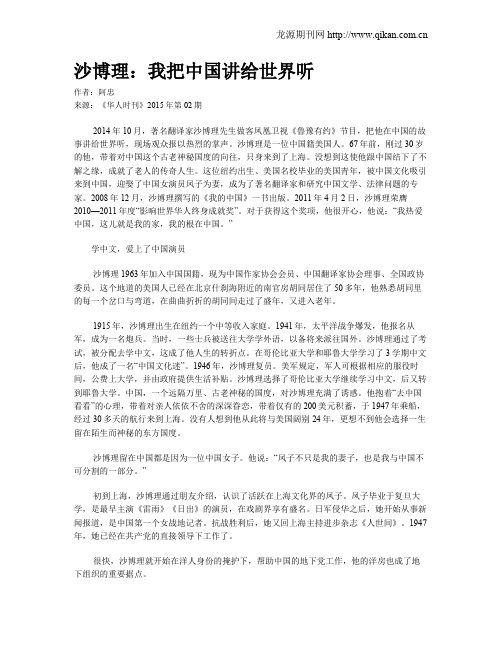
沙博理:我把中国讲给世界听作者:阿忠来源:《华人时刊》2015年第02期2014年10月,著名翻译家沙博理先生做客凤凰卫视《鲁豫有约》节目,把他在中国的故事讲给世界听,现场观众报以热烈的掌声。
沙博理是一位中国籍美国人。
67年前,刚过30岁的他,带着对中国这个古老神秘国度的向往,只身来到了上海。
没想到这使他跟中国结下了不解之缘,成就了老人的传奇人生。
这位纽约出生、美国名校毕业的美国青年,被中国文化吸引来到中国,迎娶了中国女演员凤子为妻,成为了著名翻译家和研究中国文学、法律问题的专家。
2008年12月,沙博理撰写的《我的中国》一书出版。
2011年4月2日,沙博理荣膺2010—2011年度“影响世界华人终身成就奖”。
对于获得这个奖项,他很开心,他说:“我热爱中国,这儿就是我的家,我的根在中国。
”学中文,爱上了中国演员沙博理1963年加入中国国籍,现为中国作家协会会员、中国翻译家协会理事、全国政协委员。
这个地道的美国人已经在北京什刹海附近的南官房胡同居住了50多年,他熟悉胡同里的每一个岔口与弯道,在曲曲折折的胡同间走过了盛年,又进入老年。
1915年,沙博理出生在纽约一个中等收入家庭。
1941年,太平洋战争爆发,他报名从军,成为一名炮兵。
当时,一些士兵被送往大学学外语,以备将来派往国外。
沙博理通过了考试,被分配去学中文,这成了他人生的转折点。
在哥伦比亚大学和耶鲁大学学习了3学期中文后,他成了一名“中国文化迷”。
1946年,沙博理复员。
美军规定,军人可根据相应的服役时间,公费上大学,并由政府提供生活补贴。
沙博理选择了哥伦比亚大学继续学习中文,后又转到耶鲁大学。
中国,一个远隔万里、古老神秘的国度,对沙博理充满了诱惑。
他抱着“去中国看看”的心理,带着对亲人依依不舍的深深眷恋,带着仅有的200美元积蓄,于1947年乘船,经过30多天的航行来到上海。
没有人想到他从此将与美国阔别24年,更想不到他会选择一生留在陌生而神秘的东方国度。
默默无闻、掷地有声:对外传播的伟大践行者沙博理先生
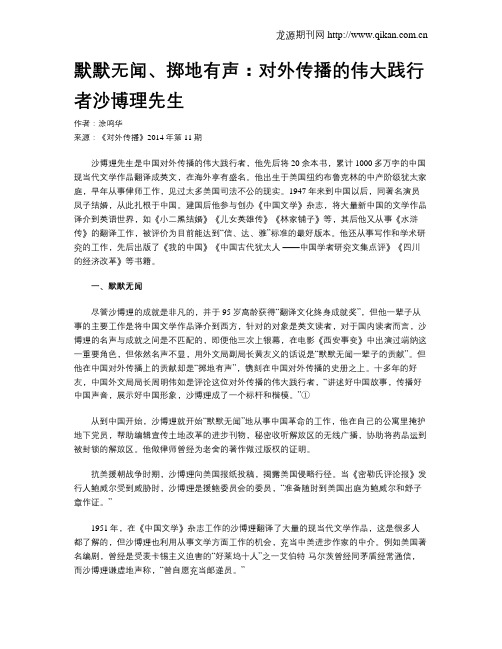
默默无闻、掷地有声:对外传播的伟大践行者沙博理先生作者:涂鸣华来源:《对外传播》2014年第11期沙博理先生是中国对外传播的伟大践行者,他先后将20余本书,累计1000多万字的中国现当代文学作品翻译成英文,在海外享有盛名。
他出生于美国纽约布鲁克林的中产阶级犹太家庭,早年从事律师工作,见过太多美国司法不公的现实。
1947年来到中国以后,同著名演员凤子结婚,从此扎根于中国。
建国后他参与创办《中国文学》杂志,将大量新中国的文学作品译介到英语世界,如《小二黑结婚》《儿女英雄传》《林家铺子》等,其后他又从事《水浒传》的翻译工作,被评价为目前能达到“信、达、雅”标准的最好版本。
他还从事写作和学术研究的工作,先后出版了《我的中国》《中国古代犹太人——中国学者研究文集点评》《四川的经济改革》等书籍。
一、默默无闻尽管沙博理的成就是非凡的,并于95岁高龄获得“翻译文化终身成就奖”,但他一辈子从事的主要工作是将中国文学作品译介到西方,针对的对象是英文读者,对于国内读者而言,沙博理的名声与成就之间是不匹配的,即便他三次上银幕,在电影《西安事变》中出演过端纳这一重要角色,但依然名声不显,用外文局副局长黄友义的话说是“默默无闻一辈子的贡献”。
但他在中国对外传播上的贡献却是“掷地有声”,镌刻在中国对外传播的史册之上。
十多年的好友,中国外文局局长周明伟如是评论这位对外传播的伟大践行者,“讲述好中国故事,传播好中国声音,展示好中国形象,沙博理成了一个标杆和楷模。
”①从到中国开始,沙博理就开始“默默无闻”地从事中国革命的工作,他在自己的公寓里掩护地下党员,帮助编辑宣传土地改革的进步刊物,秘密收听解放区的无线广播,协助将药品运到被封锁的解放区。
他做律师曾经为老舍的著作做过版权的证明。
抗美援朝战争时期,沙博理向美国报纸投稿,揭露美国侵略行径。
当《密勒氏评论报》发行人鲍威尔受到威胁时,沙博理是援鲍委员会的委员,“准备随时到美国出庭为鲍威尔和舒子章作证。
《水浒传》沙博理译本的研究
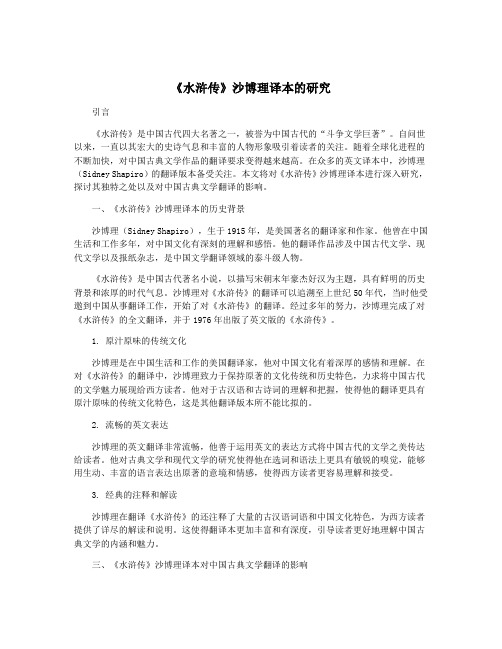
《水浒传》沙博理译本的研究引言《水浒传》是中国古代四大名著之一,被誉为中国古代的“斗争文学巨著”。
自问世以来,一直以其宏大的史诗气息和丰富的人物形象吸引着读者的关注。
随着全球化进程的不断加快,对中国古典文学作品的翻译要求变得越来越高。
在众多的英文译本中,沙博理(Sidney Shapiro)的翻译版本备受关注。
本文将对《水浒传》沙博理译本进行深入研究,探讨其独特之处以及对中国古典文学翻译的影响。
一、《水浒传》沙博理译本的历史背景沙博理(Sidney Shapiro),生于1915年,是美国著名的翻译家和作家。
他曾在中国生活和工作多年,对中国文化有深刻的理解和感悟。
他的翻译作品涉及中国古代文学、现代文学以及报纸杂志,是中国文学翻译领域的泰斗级人物。
《水浒传》是中国古代著名小说,以描写宋朝末年豪杰好汉为主题,具有鲜明的历史背景和浓厚的时代气息。
沙博理对《水浒传》的翻译可以追溯至上世纪50年代,当时他受邀到中国从事翻译工作,开始了对《水浒传》的翻译。
经过多年的努力,沙博理完成了对《水浒传》的全文翻译,并于1976年出版了英文版的《水浒传》。
1. 原汁原味的传统文化沙博理是在中国生活和工作的美国翻译家,他对中国文化有着深厚的感情和理解。
在对《水浒传》的翻译中,沙博理致力于保持原著的文化传统和历史特色,力求将中国古代的文学魅力展现给西方读者。
他对于古汉语和古诗词的理解和把握,使得他的翻译更具有原汁原味的传统文化特色,这是其他翻译版本所不能比拟的。
2. 流畅的英文表达沙博理的英文翻译非常流畅,他善于运用英文的表达方式将中国古代的文学之美传达给读者。
他对古典文学和现代文学的研究使得他在选词和语法上更具有敏锐的嗅觉,能够用生动、丰富的语言表达出原著的意境和情感,使得西方读者更容易理解和接受。
3. 经典的注释和解读沙博理在翻译《水浒传》的还注释了大量的古汉语词语和中国文化特色,为西方读者提供了详尽的解读和说明。
这使得翻译本更加丰富和有深度,引导读者更好地理解中国古典文学的内涵和魅力。
沙博理
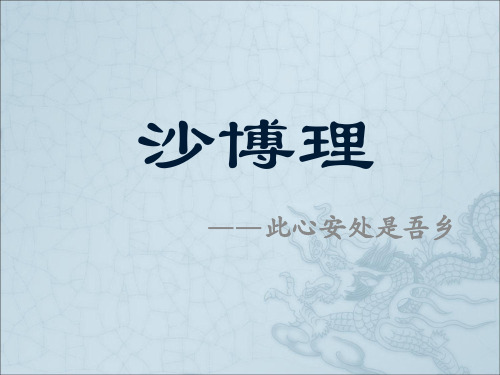
人物生活
1947年春天,沙博理抱着‚到中国看看‛的心理,带着 仅有的200美元积蓄只身来到上海,之前他在美国只学了9个 月的中文,令他没有想到的是,这个决定让他从此与中国结下 了不解之缘。 在上海落脚后的沙博理,遇到了改变他一生的女人,也就 是他后来的妻子——凤子。 婚后的沙博理,由于一次偶然的机会,开始尝试接触一个 全新的领域——翻译。从1956年第一本译著出版开始,几十 年来他一直笔耕不辍,把中国的很多著名作品都翻译成了英文, 通过这些翻译作品,向世界传播了中国的形象,努力让世界认 识一个真实的中国。 1963年由周恩来总理批准加入中国国籍,是当时第一批加入 中国国籍的外国人 ,并在此后经历了文化大革命、改革开放 等历史大事件。 自1983年沙博理离休后当选为第六届全国政协委员以来,一 直连任至今他始终积极参政议政,常到全国各地考察,对一些 问题提议案,行使政协委员的权利和责任。沙博理被称为是 ‚陪伴中国人民走过半个多世纪的真诚朋友‛。
四字格句式
原文:长老道:‚遇林而起,遇山而富,遇水而兴,遇江而止。‛
赛译: The abbot replied,‘When you see the forest, then you will rise. When you see the mountain ,then you will become rich. When you see a great city you are to move from it. When you see the great river, there you must stay.’ 沙译: The abbot intoned:‘Take action in the forest, prosper in the mountain, flourish amid the waters, but halt at the river.
沙博理:中国当代翻译史上一位特殊翻译家

沙博理:中国当代翻译史上一位特殊翻译家本文已经发表在《东方翻译》2011年第4期沙博理:中国当代翻译史上一位特殊翻译家一、一份沉甸甸的履历沙博理,1915年生于美国犹太家庭,22岁毕业于圣约翰大学法律系。
第二次世界大战期间,加入美国陆军;退伍后先后进入哥伦比亚大学、耶鲁大学学习汉语和中国历史文化。
1947年4月,远渡重洋来到中国上海,由同情进步活动转而投身中国革命;次年与著名演员、进步作家凤子结婚。
1949年10月1日,夫妇俩人应邀在天安门前观礼台参加开国大典,从此定居中国。
1951-1983年间,沙博理先后在对外文化联络局、外文出版社、《人民画报》社工作,作为外国专家担任翻译和编辑。
1963年,由周恩来批准加入中国国籍。
1983年退休至今,连续担任第6-11届全国政协委员。
沙博理专事汉英翻译长达50年,他不仅翻译了巴金、茅盾、孙犁等人的小说、散文、诗歌作品,还翻译了四大古典名著之一《水浒传》和记录“文革”历史并承载着中国当代思想史的长篇传记《我的父亲邓小平:“文革”岁月》,译著总字数约一千万,为中国文学翻译事业和对外文化交流做出了杰出贡献,也因此获得多种荣誉:1995年,中华全国文学基金会及中国作家协会中外文学交流委员会颁发的“彩虹翻译奖”;2009年,中国外文局授予的“国际传播终身荣誉奖”;2010年,中国翻译协会授予的“中国翻译文化终身成就奖”;2011年,凤凰卫视及凤凰新媒体等十余家华文媒体和机构颁发的“影响世界华人终身成就奖”。
二、沙博理翻译生涯三阶段沙博理从1951年起担任专职翻译和外国专家,主要从事汉-英文学翻译。
他所供职的外文出版社和《人民画报》社,隶属于中央直属的中国外文出版发行事业局,负责对外宣传报道和出版。
由于在这样特殊的国家对外部门工作,沙博理的翻译生涯在很大程度上同新中国成立以来的历史阶段划分相吻合。
为此我们把他的翻译生涯也分为三个阶段。
1) 新中国十七年:红色革命文学的翻译从1951年到“文革”开始之前这一阶段可谓沙博理翻译生涯的高峰期。
沙博理翻译风格研究——基于文本《水浒传》

第52卷第7期2018年7月广东蚕业GUANGDONG CANYEV 〇L52,N 〇.07July. 2018DOI : 10.3969/j .jssn .2095—1205.2018.07.52沙博理翻译风格研究一一基于文本《水浒传》李阳(牡丹江师范学院应用英语学院黑龙江牡丹江157000)摘要美国著名汉学家西里尔伯奇曾说:“旧译本只是将《水浒传》部分地带给了西方,而沙博理的成就要比原来的译 本优秀三倍。
他的中文知识使这个译本更加准确、直截了当,而它易懂的英文也比旧本更加优美得体。
”文章将围绕着沙博理翻译的《水浒传》进行深刻的探讨。
关键词水浒传;沙博理;翻译风格;文体翻译中图分类号:H 059 文献标识码:C文章编号:2095-1205(2018)07-85-021 作者及翻译作品简介在中国当代翻译史上,沙博理是一位占有特殊地位和 地位的翻译家。
1937,他毕业于纽约圣约翰大学,在二战 期间就读于康奈尔大学。
战后,他进入哥伦比亚大学、耶 鲁大学学习汉语。
1947年四月,他来到中国,在对外文化 关系局工作。
1954后,他在中国画报外文出版局工作。
1952,他开始出版翻译,翻译了超过20篇中国文学作品。
水浒传作为四大名著之一,具有很高的历史地位。
它 是第一部以农民起义为主题的小说,也是中国白话文学史 上的里程碑。
2沙博理翻译风格一基于文本《水浒传》在众多版本中,沙博理的版本被认为是最权威的版本。
在译本中,他将直译与意译、归化和异化完美结合。
他把自己对这部小说的理解融人到翻译中,使小说的文化 背景和语言风格以及他自己的视角在读者眼前得以展现。
在翻译过程中,他严格遵循原文,包括选词、修辞、语 调。
在这个版本中,绰号、道教词汇和成语的翻译都是基 于沙博理全面而仔细的选择。
在阅读时,外国读者将清楚 地看到每个作者想展现的人物。
水浒传翻译之所以如此精彩,是因为沙博理运用了许 多翻译策略。
特别是数字词和地名。
中国籍犹太翻译家沙博理简介
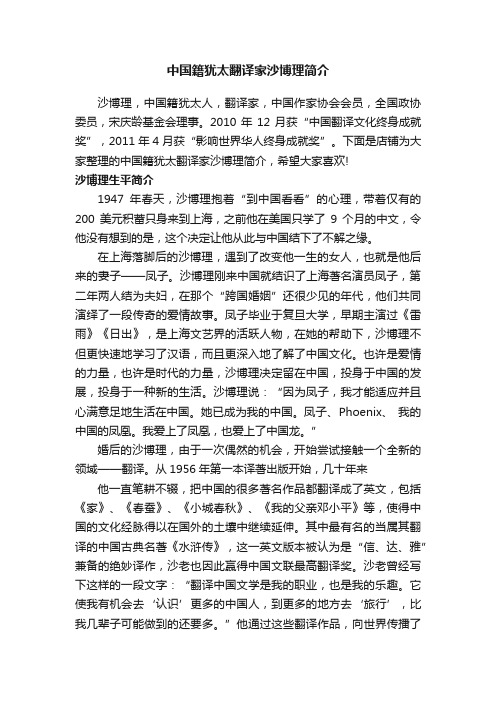
中国籍犹太翻译家沙博理简介沙博理,中国籍犹太人,翻译家,中国作家协会会员,全国政协委员,宋庆龄基金会理事。
2010年12月获“中国翻译文化终身成就奖”,2011年4月获“影响世界华人终身成就奖”。
下面是店铺为大家整理的中国籍犹太翻译家沙博理简介,希望大家喜欢!沙博理生平简介1947年春天,沙博理抱着“到中国看看”的心理,带着仅有的200美元积蓄只身来到上海,之前他在美国只学了9个月的中文,令他没有想到的是,这个决定让他从此与中国结下了不解之缘。
在上海落脚后的沙博理,遇到了改变他一生的女人,也就是他后来的妻子——凤子。
沙博理刚来中国就结识了上海著名演员凤子,第二年两人结为夫妇,在那个“跨国婚姻”还很少见的年代,他们共同演绎了一段传奇的爱情故事。
凤子毕业于复旦大学,早期主演过《雷雨》《日出》,是上海文艺界的活跃人物,在她的帮助下,沙博理不但更快速地学习了汉语,而且更深入地了解了中国文化。
也许是爱情的力量,也许是时代的力量,沙博理决定留在中国,投身于中国的发展,投身于一种新的生活。
沙博理说:“因为凤子,我才能适应并且心满意足地生活在中国。
她已成为我的中国。
凤子、Phoenix、我的中国的凤凰。
我爱上了凤凰,也爱上了中国龙。
”婚后的沙博理,由于一次偶然的机会,开始尝试接触一个全新的领域——翻译。
从1956年第一本译著出版开始,几十年来他一直笔耕不辍,把中国的很多著名作品都翻译成了英文,包括《家》、《春蚕》、《小城春秋》、《我的父亲邓小平》等,使得中国的文化经脉得以在国外的土壤中继续延伸。
其中最有名的当属其翻译的中国古典名著《水浒传》,这一英文版本被认为是“信、达、雅”兼备的绝妙译作,沙老也因此赢得中国文联最高翻译奖。
沙老曾经写下这样的一段文字:“翻译中国文学是我的职业,也是我的乐趣。
它使我有机会去‘认识’更多的中国人,到更多的地方去‘旅行’,比我几辈子可能做到的还要多。
”他通过这些翻译作品,向世界传播了中国的形象,努力让世界认识一个真实的中国。
沙博理政治讽刺诗英译艺术探究

了诗歌 的文学地位外 ,更为重要 的是其政治影 响
{ I }本文系 国家社会科q:  ̄ ̄ z - 般项 目 “ 国家翻译实践 中的 ‘ 外 来译家 ’研 究” ( 项 目号 :1 2 B Y Y 0 1 8 ) 和中 国外文 局 “ 沙博理研究 中 心 ”中 国海洋大学研究基地阶段性成果。
人 的文化立 场 去解读 政 治讽 刺诗 背后 的政 治讽 刺功 能 ,然后 在翻译 过程 中基 于双 重文化 身份 ,采 取 多 种变 通 手 段 , 以 “ 英语 读 者” 的视 角把握 全文 , 使译 诗在 措辞 、诗 句力量 和篇 章形 式方 面既 近似 于
英诗的语 言和表达 方式 ,又能传 达原诗的政治价 值 ,做到了他本人所说 的 “ 不但要让外 国人看 得 懂 ,而且 要让外 国人感 觉到 中国文学 的高水 平 ” ( 洪捷 2 0 1 2 ) ,实现了保持 目的语读 者取向和再现
( 黄新渠译注 的 《 鲁迅诗歌》 、吴钧陶译注的 《 鲁 迅诗歌选集》 等)也 均收录了几首讽刺诗 ( 北塔
2 0 1 3 ) 。二 、出现 在 中国诗 歌选 集 英 译 本 中 ,如 许
理翻译艺术研究 以及现代讽刺诗的英译都具有不可 忽视 的研究价值 。本文拟从创造性词语转译 、诗句 力量 再 现 和 篇 章 形 式 重 构 ,探 讨 《 酱 油 和对 虾 :
新 中国成立 不久 政府 就设 立 了专 门 的国家 级翻
2 )在 《 讽刺诗这朵花—— ( 中国百家讽刺诗选) 序》 一文 中说 : “ 四十年代 的讽刺诗 ,来势之猛 ,
如爆 雷滚滚 ,如潮水 高涨 ;影 响之 大 ,如穿破 云 的
波澜壮阔不显惊
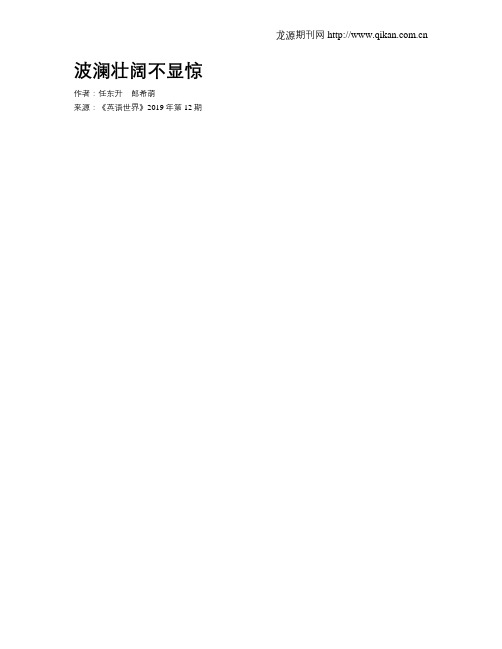
波澜壮阔不显惊作者:任东升郎希萌来源:《英语世界》2019年第12期犹太裔中国籍翻译家沙博理(Sidney Shapiro, 1915—2014)出生并成長于美国,而立之年来到中国生活和工作,又三十年步入花甲。
1979年,他回首往事,记忆满满,于是动手用母语书写自传An American in China:Thirty Years in the People’s Republic(《一个美国人在中国:在中华人民共和国的卅年》),由北京新世界出版社推出精装本,纽约新美国图书馆(New American Library)出版平装本。
或许因为1983年退休后,沙老生活闲适、身体康健,或许又亲历近20年中国改革开放新变化,他对中国和国际形势产生更深入的思索。
1997年,沙博理调整自传章节结构,增加篇幅,由新世界出版社再次刊印,重新取名为My China: The Metamorphosis of a Country and a Man(《情系中华五十年》)。
同时2000年,新版自传经纽约Hippocrene Books出版,更名为I Chose China: The Metamorphosis of a Country and a Man。
从自传名称的变化,可以看出沙博理对中国的依恋越来越深。
他“试图通过自传,讲述中国历史上重大变革中的某些事,就像呈现离心机中一个微小颗粒”3,希望更多西方读者了解中国历史与现状的初衷未改。
1. 措辞纪实生动,波澜壮阔不显惊1947年,沙博理从美国乘船抵达上海码头,一时间产生了“文化休克”:他头一回看到男子穿着民国时期的黑色“长袍”沿江岸跑,心生疑惑这难道就是中世纪的僧侣,这个东方古国颇有些让人身处中世纪的错觉。
上岸后,面对上海车辆、行人及店铺喇叭的交织喧闹,以及扑面而来各式小吃与汽车尾气的混合气味,沙博理踉踉跄跄地闯入了东方的文化旋涡中。
当时上海处于临战状态,沙博理对社会贫富悬殊刻画真切,对普通市民、乡下人、穷人乃至乞丐都有着墨。
世界因你而美丽——沙博理:不辞长作中国人

世界因你而美丽——沙博理:不辞长作中国人
丁庆龙
【期刊名称】《华人世界》
【年(卷),期】2011(000)005
【摘要】作为一个花开五度的品牌盛事,4月2日晚的北京大学百周年纪念讲堂,凤凰卫视、凤凰新媒体将和海内外十余家华文媒体一起,带领全球华人在“世界因你而美丽——影响世界华人盛典2010—2011”中再一次向榜样致敬。
十二个响
亮的名字又一次响彻在这熟悉的礼堂,他们分别是获得“影响世界华人终身成就奖”的沙博理和获颁“影响世界华人大奖”的鲍哲南、“天河一号”研发团队、上海世博会、台北花博会、韦鸣恩、李娜、蒋文文/蒋婷婷、葛优、杨丽萍、中央芭蕾舞团和李颖欣、杨兆楠、陈婉玲。
他们是华人中的骄傲,世界因他们而美丽。
【总页数】6页(P54-59)
【作者】丁庆龙
【作者单位】不详
【正文语种】中文
【中图分类】F461.167
【相关文献】
1.若使茶山解冻雨,不辞长作晚归人 [J], 瞿杲
2.《不辞长作岭南人》二度创作的原则性把握 [J], 李暮凡; 马钰; 刘宁希
3.日啖荔枝三百颗,不辞长作岭南人寓居惠州:不可救药的乐天派 [J], 黄金生
4.不辞长作新闻人 [J], 张宗善
5.阅尽《舌三》满屏香,不辞长作中国人——观《舌尖上的中国》第三季有感 [J], 苑嘉颖;许艳红(指导教师)
因版权原因,仅展示原文概要,查看原文内容请购买。
96岁著名翻译家沙博理获“影响世界华人终身成就奖”

96岁著名翻译家沙博理获“影响世界华人终身成就奖”【】近日,“世界因你而美丽——影响世界华人盛典2010-2011”最受瞩目奖项“终身成就奖”获颁人已经确定,著名翻译家沙博理最终荣膺2010-2011年度“影响世界华人终身成就奖”。
综合中新网和北京青年报报道,这是盛典举办四届以来,首次将这一奖项颁给在华人领域极具影响力的中国籍犹太人。
此前,获得这一奖项的有诺贝尔奖获得者杨振宁,“杂交水稻之父”袁隆平,科学巨人钱学森和当代文豪、武侠巨匠金庸。
他自称是华籍美人,意外来到中国,却从此扎下根,一呆就是六十几年;他爱上中国的一位美丽女子,与她喜结良缘,在风雨中牵手相依,终生不渝;他被中国文化深深吸引,众多脍炙人口的著作都被他翻译成了英文,送到了世界读者的面前;他关心中国的发展,身任政协委员的他,时常到各地考察,并提出许多富有建设性的提案;他将自己与中国紧紧连在了一起,他说,中国就是他的家,他的根儿已经在中国。
他就是著名翻译家沙博理。
而对于获得“影响世界华人终身成就奖”,沙老称很开心。
今年已九十六岁高龄的沙博理原名Sidney Shapiro,中文名取自“博学明理”之意。
1947年春天,他抱着“到中国看看”的心理,带着仅有的200美元积蓄只身来到上海,令他没有想到的是,这个决定让他从此与中国结下了不解之缘。
专访沙博理:对凤与龙献出毕生的爱在沙博理的自传《我的中国》里,他曾写下过这样一段话:“我爱上了凤,也爱上了龙。
了解和热爱中国龙,使我更加热爱和珍视我的中国的凤。
”沙老所爱的凤与龙,是他的妻子凤子和他现在的故乡中国。
沙博理凤子的爱情故事,是中国文艺界口口相传的一段佳话。
1947年,刚刚从美国陆军退伍的青年小伙沙博理,带着只学过几个月的中文和200美元退伍军费,搭上了开往中国上海的小货船。
刚抵达上海的他,在热心同学的帮助下,很快就认识了一位“中文老师”,也就是他后来的爱人——凤子。
凤子毕业于复旦大学,早期主演过《雷雨》、《日出》,是上海文艺界的积极分子。
沙博理翻译成就与翻译思想研究

沙博理翻译成就与翻译思想研究刁洪;侯复旦【期刊名称】《长沙大学学报》【年(卷),期】2015(000)001【摘要】沙博理在翻译中国文学作品、传播中国优秀文化方面取得了令人瞩目的成就。
结合沙先生的生平和历史背景,梳理其翻译成果,分析其翻译风格和翻译思想,阐述其英译作品在中西方文化交流中的现实意义和学术意义,以深切纪念这位翻译名家,并引起翻译界对我国现当代文学作品英译的重视。
%Sidney Shapiro has made remarkable contribution to the translation of Chinese literature and the promotion of Chinese culture in foreign lands.This paper,based on Sidney Shapiro’s life experience and historical background,illustrates his translation works, translation ideology and contribution.The aim is to commemorate this great translator and arouse the attention of other scholars to the English translation of Chinese literature.【总页数】3页(P101-103)【作者】刁洪;侯复旦【作者单位】浙江海洋学院外国语学院,浙江舟山 316022;四川外国语大学国际教育学院,重庆 400031【正文语种】中文【中图分类】I03【相关文献】1.五四初期刘半农先生的翻译成就与创新 [J], 韩露2.李俍民翻译成就与翻译思想考 [J], 刘立胜3.冰心外国文学翻译成就与翻译观 [J], 赵敏4.萧乾的翻译成就与思想概述 [J], 李娟;王金容;5.萧乾的翻译成就与思想概述 [J], 李娟; 王金容因版权原因,仅展示原文概要,查看原文内容请购买。
周明伟:我与沙老的十年——中国外文局局长谈沙博理
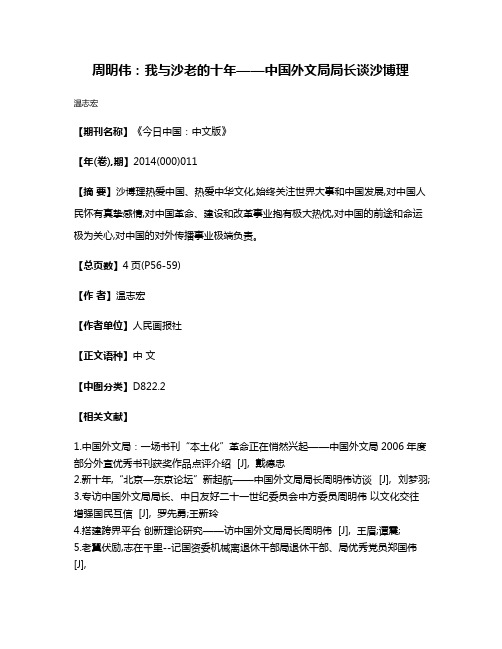
周明伟:我与沙老的十年——中国外文局局长谈沙博理
温志宏
【期刊名称】《今日中国:中文版》
【年(卷),期】2014(000)011
【摘要】沙博理热爱中国、热爱中华文化,始终关注世界大事和中国发展,对中国人民怀有真挚感情,对中国革命、建设和改革事业抱有极大热忱,对中国的前途和命运极为关心,对中国的对外传播事业极端负责。
【总页数】4页(P56-59)
【作者】温志宏
【作者单位】人民画报社
【正文语种】中文
【中图分类】D822.2
【相关文献】
1.中国外文局:一场书刊“本土化”革命正在悄然兴起——中国外文局2006年度部分外宣优秀书刊获奖作品点评介绍 [J], 戴德忠
2.新十年,“北京—东京论坛”新起航——中国外文局局长周明伟访谈 [J], 刘梦羽;
3.专访中国外文局局长、中日友好二十一世纪委员会中方委员周明伟以文化交往增强国民互信 [J], 罗先勇;王新玲
4.搭建跨界平台创新理论研究——访中国外文局局长周明伟 [J], 王眉;谭震;
5.老翼伏励,志在千里--记国资委机械离退休干部局退休干部、局优秀党员郑国伟[J],
因版权原因,仅展示原文概要,查看原文内容请购买。
- 1、下载文档前请自行甄别文档内容的完整性,平台不提供额外的编辑、内容补充、找答案等附加服务。
- 2、"仅部分预览"的文档,不可在线预览部分如存在完整性等问题,可反馈申请退款(可完整预览的文档不适用该条件!)。
- 3、如文档侵犯您的权益,请联系客服反馈,我们会尽快为您处理(人工客服工作时间:9:00-18:30)。
Marriage
• (1)对回前诗的省略
• (2)对重复叙事的“重写”
• 武松答道:“一言难尽!自从与你相别之后,到 得牢城营里,得蒙施管营儿子,唤做金眼彪施 恩……四更三点跳城出来,走了一五更路,一时 困倦,棒疮发了又疼,因行不得,投一小庙里权 歇一歇,却被这四个绑缚将来。” • Wu Song told the whole story——from his beating of Jiang the Gate Guard Giant, to his frame-up by Jiang, Commandant Zhang and General Zhang, his terrible revenge against them all, to his final capture by the four in the temple..
沙博理翻译思想评述
• 沙博理的翻译思想 • 沙博理的翻译策略 • 沙博理的心声:让中国文译中要内容和风格并举,不 容偏废 • 翻译准则上基本赞同“信、达、雅”的主 张 • 译文特质:信而不死、活而不乱
翻译策略
• 异化为主,最大程度保留中国文化 • 适当变通,兼顾原文整体效果和英语读 者习惯
三、展现新中国发展、讴歌劳动人民 : 《农村散记》(Village Sketches, 1957)、 《创业史》(Builders of a New Life, 1964)、 《夫妻之间》(Between husband and wife: A Play in One Act, 1953)、 • 《巧媳妇/古代故事画库》(Mistress Clever, 1954)、 • 《酱油和对虾》(Soy Sauce and Prawns, 1963) • • • •
Major Glories
• 1995年,荣获“彩虹翻译奖”; • 2009年, 荣获“国际传播终身荣誉 奖”; • 2010年, 荣获“中国翻译文化终身成 就奖”; • 2011年, 荣获“影响世界华人终身成 就奖”。
Translation Career
• 新中国十七年:红色革命文学的翻译 • “文革”十年:《水浒传》译名之争 • 新时期三十年:自主的译者和作者
博学明理
• 取名“沙博理”,意思是“博学明理” • 《礼记·中庸》:“博学之,审问之,慎思 之,明辨之,笃行之。” • 《文心雕龙·事类》:“此全引成辞,以明 理者也。 ” • “沙”是英文姓的音译
General Introduction
• 1947年4月,远渡重洋,来到中国上海。 • 1949年10月,参加开国大典,定居中国。 • 1951-1983年间,沙博理先后在对外文化联 络局、外文出版社、《人民画报》社工作, 作为外国专家担任翻译和编辑。 • 1963年,由周恩来批准加入中国国籍。 • 1983年退休至今,连续担任第6-11届全国 政协委员。
• 《一个美国人在中国》(An American in China, 1979)、 • 《四川的经济改革》(Experiment in Sichuan: a Report on Economic Reform, 1981)、 • 《马海德:美国医生乔治·哈特姆在中国的 传奇》(Ma Haide: The Saga of American Doctor George Hatem in China, 1993)、 • 《我的中国》(My China: The Metamorphosis of a Country and a Man, 1997)
一个美国人的半生中国缘
沙博理
Sidney Shapiro
• Born in December 23, 1915, in New York • Graduated from St.John’s University when he was 22. • Joyed the Army during WWII, later he went to Columbia University and Yale University to learn Chinese and Chinese History Culture. • Came to China in 1947.
• 《中国古代犹太人:中国学者研究文集点评》 (Jews in Old China: Studies by Chinese Scholars, 1984), • 《中国古代刑法与案例传说》(The Law and the Lore of China’s Criminal Justice, 1988), • 《中国文学集锦:从明代到毛泽东时代》(A Sampler of Chinese Literature From Ming Dynasty to Mao Zedong, 1996)。 • 《湖畔儿语》(The Child at the Lakeside)、 • 《春桃》(Big Sister Liu)、 • 《月牙儿》(Crescent Moon)、 • 《小二黑结婚》(The Marriage of Young Blacky)
• 二、揭露封建礼教和官僚、反映解放后阶 级斗争 : • 李有才板话及其他故事》(Rhymes of Li Yu-tsai and Other Stories /Rhymes of Li Youcai and Other Stories, 1950)、 • 《柳堡的故事》(It happened at Willow Castle, 1951)、 • 《活人塘》(Living Hell, 1955), • 《春蚕集》(Spring Silkworms and Other Stories, 1956)、 • 《家》(The Family, 1958)
• ……见一条大汉,……手里拿着一口宝刀, 插着个草标儿,立在街上……(第七回) • …He was holding a fine sword in his hand, with a tuft of grass tied to it indicating that it was for sale. • 沙博理力求再现原语文化特色,采取了增 译法,“indicating that it was for sale”一句 表明了插草标的含义是卖刀 。
• 一、集中表现中国人民抗日斗争 : • 《铜墙铁壁》(Wall of Bronze, 1954)、 • 《平原烈火》(The Plains are Ablaze, 1955)、 • 《新儿女英雄传》(Daughters and Sons, 1956)、 • 《保卫延安》(Defend Yenan!, 1958)、 《小城春秋》(Annals of a Provincial Town, 1959), • 《林海雪原》(Tracks in the Snowy Forest, 1962)
